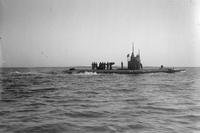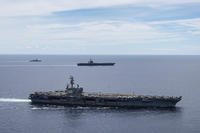In a new research paper I came across, Geoffrey Till, a top-notch historian and naval strategist, looks at the notion that this is shaping up to be China’s century, not America’s, and that the maritime decline of the U.S. is a foregone conclusion. He contends that predicting the rise and fall of great power maritime dominance is a bit trickier and harder to measure than many claim.
The debate itself is being driven by economics, of course; China’s GDP witnessed an astonishing 10-fold increase between 1978 and 2004. A “highly effective” government stimulus program and massive credit expansion meant China recovered quickly from the financial crisis; the U.S. has not. In 2000, U.S. GDP was eight times larger than China’s; now it’s only four times larger. “Historically, growth in GDP has a high correlation with naval expenditure,” writes Till.
The other major driver is China’s “growing and absolute dependence on overseas commodities, energy and markets.” That fact alone means China “has little choice but to become more maritime in its orientation.” Some of China’s naval modernization can be seen as making up for decades of neglect.
What about the naval balance? While the Navy’s planned expansion to 313 ships may never happen, its current level of 280 ships seems overwhelming, says Till. Numbers of ships don’t tell the whole story. Borrowing from Bob Work’s analysis, Till cites tonnage as a better indicator of fleet strength as “the offensive and defensive power of an individual unit is usually a function of size.”
Tonnage wise, the U.S. battle fleet has a 2.63:1 advantage over a combined Chinese-Russian fleet. Factoring in the advantage the U.S. Navy possesses in its vertical launch magazines (actual strike power) an enormous 20-power superiority exists. That’s not all:
“Its 56 SSN/SSGN nuclear power submarine fleet might on the face of it seem overpowered by the world’s other 220 SSNs and SSKs but the qualitative advantages of the U.S. submarine force are huge. It is much the same story with regard to the U.S. Navy’s amphibious and critical support fleets, in its capacity to support special forces operations, in its broad area maritime surveillance capabilities, in its U.S. Coast Guard (the equivalent of many of the world’s navies) and in the enormous advantage conferred by the experience of many decades of 24/7 oceanic operations.”
The real strength of a navy should be measured not by the number of units, Till argues, but how those compare to the requirements the platform is intended to perform.
Till also questions Chinese shipbuilding prowess, noting deficiencies in quality assurance, innovation and experience expected in “an industry in the first flush of youth.” While China’s manufacturing success is impressive, it remains mostly labor-intensive, low priced consumer items. It remains far behind Germany and Japan in technological innovation and the export of machinery.
-- Greg Grant









